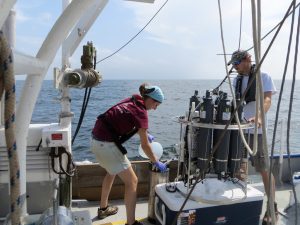Scientific Dream Team Conducts Rapid Response Research at Hercules Gas Blowout
– November 12, 2013
(From Fall 2013 Newsletter) It started with radio chatter about a gas rig blowout heard on a research vessel early Tuesday morning. A few days later an all-star science team from across the Gulf region sailed from Cocodrie, Louisiana on the R/V Acadiana to the Hercules site. The vessel was loaded with ocean drifters to track movement of surface waters around the rig and with equipment to collect time-sensitive samples of water, air, and sediment. Working with federal authorities, the research team received sampling access to within 500 meters of the rig.
A flurry of emails and phone calls on Tuesday turned into meetings on Wednesday. Researchers quickly generated real-time models to support plans for drifter deployments and sampling sites and obtained use of a vessel. On Thursday and Friday, teams loaded equipment into vehicles or hurriedly prepped them for express shipment and then travelled to Cocodrie and loaded the vessel. The first expedition left port on Saturday at 6 AM in bad weather and rough seas and sailed to the incident site. That afternoon and evening, despite challenging conditions, drifters were transmitting GPS signals of their movement and researchers began collecting water and sediment samples. The crew returned to port around midnight for rest and supplies. On Sunday evening the vessel left port again and science crews continued their work through Tuesday, successfully gathering important data.
This gas-well blowout represents a unique opportunity to document impacts of contaminants in a shallow water environment. The foresight, resourcefulness, and collaborative efforts of these quick-acting researchers should give the public, responders, and other scientists key information about the incident arena, at essentially its beginning, to better understand impacts as this event evolves.
Being part of the GoMRI science community played a key role in the success of this endeavor. “The GOMRI network – knowing the expertise of other GoMRI consortia and the proper people to contact – made it possible to assemble a scientific ‘dream team’ in short order,” said Samantha Joye, a biogeochemist and microbial ecologist with the University of Georgia and science lead for the ECOGIG consortium, who spearheaded this effort.
The team collected time sensitive data to establish comprehensive biological, chemical, and physical oceanographic data sets to characterize the incident area very early on in the event. Specific accomplishments included:
- deployed 21 surface drifters around the rig;
- used real-time drifter data in models that guided sampling around the rig;
- collected water samples from eight stations (at multiple depths and at different distances from the rig), including areas not impacted (up-current) and potentially impacted (down-current);
- conducted 33 CTD casts and nine sediment core casts; and
- released drift cards in support of the GISR Drift Card
Background on the Incident
In the early morning hours on Monday, July 23rd, the Hercules 252 rig owned by Walter Oil and Gas of Houston, TX blew out, spewing a mixture of gas, condensate, and possibly other hydrocarbons into the water and air. The rig is located about 55 miles south of the Louisiana coast. All workers on the rig were safely evacuated. Surface sheens periodically became visible and then dissipated at and around the blowout site. Later the rig caught fire and continued to burn until, as authorities believe, sand and sediment clogged the well, temporarily shutting off the gas flow. Responders then dug a relief well for a permanent plug.
The participating scientists and researchers are members of five GoMRI Research Consortia:
- Ecosystem Impacts of Oil and Gas Inputs to the Gulf Consortium (ECOGIG)
- Coastal Waters Consortium (CWC)
- Gulf Integrated Spill Response Consortium (GISR)
- Consortium for Advanced Research on Transport of Hydrocarbons in the Environment (CARTHE)
- Center for Integrated Modeling and Analysis of the Gulf Ecosystem (C-IMAGE)
Adapted from a longer article. Original article published here.
To hear more from the student researchers involved in the research, see this newsletter’s Community Interview.







